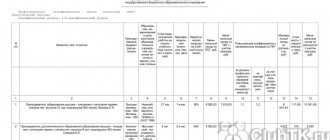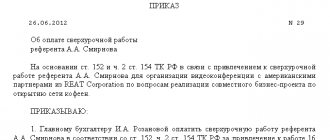Wages are the main type of income for most citizens, and for many even the only one. Therefore, this is a very important economic factor and a serious indicator not only of the cost of labor, but also of the country’s financial resource. In addition, this is the most real motivation for an employee’s work, a regulator of supply and demand in the labor market and a sign of professional status.
Let's consider the difference between the two main types of wages - real and nominal.
How is real wage ?
Real and nominal wages
The real wage is the amount of goods and services that can be purchased for a nominal wage. Nominal salary is the remuneration accrued to an employee for his work, depending on the number of hours worked or the volume of work performed.
These 2 wage-related economic terms are interrelated and are usually used together. Everyone, without exception, is familiar with nominal wages - employees see it on their payslips, although they do not use the term “nominal”. We are also very familiar with real wages - this is what is in our wallets and on bank cards.
The value of real wages (WW) depends on many factors. For example, if a company is late in paying salaries, this fact reduces the real purchasing power of employees. In our country, not only the workers themselves are trying to fight this phenomenon through trade unions, whose duty is to protect the interests of workers. The state also regulates this issue.
IMPORTANT! If the employer paid wages with a delay, he is obliged to pay compensation in accordance with Art. 236 Tax Code of the Russian Federation. The very fact of delay may serve as a reason for administrative punishment (Part 1 of Article 5.27, Part 4 of Article 5.27 of the Administrative Code), and criminal liability cannot be excluded (Article 145.1 of the Criminal Code of the Russian Federation).
What is salary?
In addition, the salary includes a variety of:
- compensation in the form of additional payments and allowances. For example, these include the northern coefficient, paid for work in special climatic conditions; payments for work in areas that are radioactively contaminated; for working overtime, etc.
- incentive payments. For example, bonuses and other remunerations that are paid for the best performance in work, etc.
Salary, including all its payments, depends on many factors , in particular:
- on the qualifications of the employee;
- on the complexity and volume of work he performs;
- on the quality of working conditions;
- from working in a budget or commercial enterprise.
In addition, wages depend on the remuneration system adopted by the enterprise, as well as on the availability and nature of incentive payments approved by local regulations, collective agreements, or otherwise.
In this regard, the maximum wage is not limited in any way, but it has a minimum threshold, which is established by law. This is the so-called minimum wage or minimum wage. The salary cannot be lower than this value (provided that the employee has worked the standard working hours established by labor legislation and has fully fulfilled the work duties assigned to him during this period).
Where concepts are applied
These definitions are usually used and applied in conjunction with another, no less well-known definition - wages. After receiving a pay slip, almost every employee sees the accrued salary, although such terminology is usually not used in the usual speech patterns of society.
The employee is also well acquainted with the second type of salary mentioned above; it is reflected in the correspondence about the receipt of money in his bank account.
In public understanding, the value of nominal and real wages differs. The amount of wages paid depends on factors such as late payment of funds by the employer, which exposes the purchasing power of employees to a decreasing trend. This problem of industrial relations is one of the most pressing.
The state has taken all measures to reduce the level of such incidents. For example, in accordance with the tax and administrative codes, the employer is obliged to pay compensation to the employee, and if payment deadlines are systematically violated, administrative sanctions will be applied to the unscrupulous employer.
The concept of nominal wages
Nominal wage is the payment for the employee’s labor activity without taking into account taxes and fees, accrued insurance premiums and expenses for clothing and food. According to another definition, this is the totality of all accruals in favor of the employee for a certain time period or for the amount of work performed. This is the amount that is specified in the employment contract concluded with the employee, that is, before personal income tax is deducted from it.
The nominal salary includes:
- Salary or tariff rate.
- Premium.
- Incentive bonuses and payments.
- Additional payment for difficult working conditions that deviate from normal (for night shifts, working overtime or on holidays).
- One-time additional payments for work performed.
The average nominal salary is determined for a certain period worked by employees: quarter, half-year or year. Typically, the term “average nominal salary” is used only at the state level in official documents; it is not used in ordinary organizations.
Nominal wages are usually expressed in national currency. But within the framework of international studies, it can be reduced to a single currency, which will make the difference between incomes more clear.
Difference between nominal and real wages
Real wages are the amount that an employee receives annually. Its concept has also not found legislative support, and in some approaches real wages are calculated taking into account purchasing power.
The difference between these types of salaries can be seen using an example . The worker's nominal salary was 30,000 rubles, of which he spends 10% on housing and communal services and other mandatory services, 50% on food, the rest remains on the purchase of clothing and other goods.
Six months later, the nominal salary remained the same - 30,000 rubles. But due to inflation and rising tariffs, the structure of expenses has changed: 25% goes to mandatory payments, 70% to food, and only 5% remains to pay for various goods and services. As a result, a person purchases much fewer goods and services for the same salary.
It turns out that while nominal wages remain unchanged, real wages have decreased . But since the concept of real wages has not found its legal codification, many understand it as wages minus personal income tax.
Parameters of nominal wages
So, we dealt with the concept of nominal wages above. It only remains to add that its size directly depends on the labor produced.
Elements of wages that form the nominal profit of an employee for various forms of remuneration:
- rate, salary, working time (amount in hours, days);
- the significance of the task performed or the number of units produced;
- summary data on the length of time worked and compliance with the quality standard;
- the size of the actual value within the period fixed by the schedule.
Each of the listed configurations has its own indicators that affect the amount of salary. Many enterprises practice additional motivation and incentives for better/faster completion of tasks: bonuses, which are applied to all forms of payment based on the results of the month, quarter or year.
Real wage parameters
As mentioned earlier, the level of real wages is an indicator of the economic growth and well-being of the country.
Characteristics of parameters influencing the size of real wages:
State intervention in them partly gives balance to the distortion of market processes. Economic and social methods of influence are used through legislative and regulatory spheres of influence.
Similarities and differences between nominal and real wages
Common features:
- Both are pay representatives.
- Presented in monetary terms and the currency in which the employer makes payments.
- Their size is not equal due to contributions to the state in the form of taxes, which must be made by the employer.
The main difference between nominal (accrued) and real wages is that nominal income, unlike real income, is in no way related to the well-being of workers and does not reflect their purchasing power.
Based on the above, it is obvious that it is the size of the real salary that is responsible for the employee’s material security.
Dependence of real wages on nominal wages
The direct codependence of real wages on nominal wages is especially clearly visible in a situation where the level of nominal wages is growing faster than inflation.
For example, the amount of accrued wages increased by 17% percent, while the inflation rate was 7%. It turns out that real wages (purchasing power) increased by 9.34%. That is, an employee can afford 9.34% more goods and services than in the previous year (month, quarter).
The opposite situation shows the dependence no less clearly. Salary growth is slower than inflation - a story we often encounter. Let's take a closer look at it.
For example, nominal wages increased by 40%, while inflation was 45%. It turns out that the size of real wages became lower by 2.33%. In other words, an employee with such data, despite a significant (in numbers) increase in nominal wages, will be able to purchase 2.33% less goods and services. That is, the standard of living of such an employee has become lower.
How is nominal wage calculated?
There are two closely interacting categories in the labor market: employers and employees.
The latter are ready to exchange their services for a monetary reward. Its size is calculated based on labor costs per unit of time. Personal factors, such as employee expenses for personal needs, as well as current market prices for goods and services, are not taken into account here.
Since wages are regarded as income received by an individual, citizens pay part of it to the state treasury in the form of taxes and insurance contributions. Naturally, the resulting salary amount will be less than that agreed upon by the terms of cooperation with the employer.
Without delving into complex economic concepts, we can say that a nominal salary is a sum of money that is accrued to an employee on paper and appears only in accounting documents. Its size is calculated taking into account the amount of work done over a certain time period (hour or month), but without taking into account various taxes and fees.
It includes the main part of the remuneration, calculated according to the adopted tariff schedule, as well as mandatory additional payments, coefficients and bonuses.
In addition, the nominal salary includes additional remunerations, which include:
- payment for sickness absence,
- vacation pay,
- payment for forced downtime,
- maternity and baby care time,
- preferential hours when employing minors,
- compensation upon dismissal.
Thus, the additional part of the salary includes all types of payments for the time during which the employee did not actually perform his official duties.
Place in the economy
The so-called purchasing power of the population is calculated on the basis of real wages. The amount of purchasing power has an inverse relationship with the consumer price index or PPI. If consumer prices rise, then purchasing power will correspondingly fall down. In economics, it is practiced to use measures to compensate for the impact of inflation by changing the PPI value upward.
The difference between the levels of nominal and real wages will be an indicator of the magnitude of inflation. The nominal wage index is the ratio of the current wage level to the wage level of the previous year, multiplied by 100. The so-called real wage index is calculated as follows: the nominal wage index is divided by the CPI and multiplied by 100.
Inflation rate
If the size of the nominal wage does not change, and inflation rises, then the purchasing power of the population also decreases, since what a person earns will not be enough to pay for the goods and services necessary for life.
In conditions of constantly growing inflation, the size of real wages will still decline even if the level of nominal wages increases. This is observed with an artificial increase in wages through forced indexation by the state. At the same time, the degree of satisfaction with the social situation of the population will decrease.
On the contrary, an increase in nominal wages in a relatively stable economic situation will indicate an increase in the level of well-being of citizens. And a slight increase in the price index will not have a critical impact on the standard of living of citizens and will even be an additional incentive for employers to increase nominal wages.
By the way, the nominal value of the work done by an employee, which is a large mathematical value, is not yet an indicator that the employee’s wages are high. During the default period of the 90s, salaries amounted to millions, and there was nowhere to spend these enormous sums due to a shortage of consumer goods.
Factors influencing the calculation of nominal wages
Below are the factors influencing the calculation of nominal wages:
- Employee's personal contribution to production. This is his experience, qualifications, existing skills, the quality of the work performed, as well as the volume performed.
- Various incentives for quality work done. These are additional payments for overtime work, increased productivity and quality of goods.
- Difficult working conditions. These are harmful production conditions, difficult working conditions and an intense work schedule.
- Methods of calculating remuneration - based on salary, a certain tariff, per unit of working time or product produced.
- The amount of time worked or the production rate.
- The minimum wage is the minimum wage. This parameter is the minimum threshold for calculating a nominal salary and depends largely on decisions at the state level.
Harmful working conditions
Scope of this concept
The types of wages are not specified in the Labor and Tax Codes, they are not distinguished in accounting, and are not used in reporting and working documentation. These terms are general economic terms and also relate to statistical information.
The general definition of wages relates to the reward for work. Looking at it from different points of view, one can define salary as:
- compensation for labor in cash;
- part of the total product in financial equivalent, which becomes the property of the worker depending on the quantity and quality of his labor costs;
- the cost of labor resources used in the production process;
- part of the expenses of a manufacturer or entrepreneur intended to pay for hired labor.
The state guarantees workers wages not lower than the minimum allowable amount established by law ( minimum wage ).
What is the minimum wage (minimum wage) ?
Factors influencing the calculation of real wages
Let's consider these factors:
- current tax burden. The higher the tax rates and the size of contributions to the Pension Fund, the lower the real wage will be. In addition to the personal income tax, the enterprise also pays the unified social tax from the salaries of its employees, the overwhelming share of which in the amount of tax payments;
- changes in the cost of consumer goods and services. This leads to a depreciation of the funds actually received by the employee;
- increase in tariffs for housing and communal services - these costs every year “eat up” an increasing part of the money received by the employee for his work;
- demand for certain specialties in the labor market. If any specialty becomes in demand, and there are not enough professionals, then the level of wages will increase;
- wage indexation is more applicable to budgetary organizations. Private organizations do not seek to revise salaries and tariff rates of workers;
- discrimination based on gender and nationality - women will be paid less than men in the same position. Migrants will be paid a minimum wage under “black” or “gray” schemes;
- delay in payment of wages. At the same time, the salary was accrued and even taken into account in statistical calculations, but the employee did not receive it;
- payment of part of the salary not in cash, but in kind - that is, in products. This method was widely practiced in the post-Soviet period. For the state system, such a factor is simply destructive - no taxes are received from barter transactions that workers were forced to engage in. It is possible that in the current crisis conditions the influence of this factor may increase.
Real and nominal wages in the current conditions of economic development are completely different things. Both of these indicators depend on each other, and each of them has its own impact on the economy.
Real wages directly affect the purchasing power of the population, and nominal wages directly affect the size of real wages. Theoretically, it is possible by legislative means to artificially adjust the level of real wages to the threshold of nominal wages, but in the current conditions this will not be possible due to growing inflation.
Importance in economics and the relationship between real and nominal wages
Let us summarize the difference between nominal wages and real wages. The first indicator reflects the amount (in monetary terms) received for labor, the second - the number of goods and services that can be purchased for this amount.
At first glance, it seems that in assessing the economic situation and standard of living, the indicator of real wages is more important, while nominal wages are something speculative, invented by theorists. It’s not so important how many banknotes you have, what matters is what you can afford with them. But this is not entirely true. In practice, these concepts are closely interrelated, since real wages depend on nominal wages. The more money is credited to the employee, the more goods he will be able to buy with it.
There is another side to this relationship: in difficult economic conditions, an increase in work in progress provokes inflation (an increase in prices for goods and services), which will lead to a decrease in the level of purchasing power of the population.
In addition, the level of work in progress in different industries and in different positions is important for assessing the status and value of an employee in society and the fairness of remuneration for work. And in official statistics this indicator is used much more often, due to the simplicity of its calculation and reflection in numerical terms. You can’t do without it in documents either.
When nominal and real incomes are compared
The ratio of types of wages allows you to monitor inflation processes. An imbalance between real consumer demand and income supply shows the unsettled nature of economic processes, in which abrupt fluctuations in each direction are an unfavorable factor in economic development.
By comparing real and nominal wage indices, the following indicators are judged:
- Inflationary processes;
- Unemployment level;
- Needs for qualified personnel;
- The need to take corrective measures.
There are many mechanisms for regulating the actual level of available funds. One of the successful mechanisms is to link the amount of remuneration to the minimum wage. The value of the indicator is set at the state level. Read also the article: → “Minimum wage (minimum wage) in the table by year.”
What is the real wage and how is its size determined?
In order to understand how to calculate real wages, it is necessary to have information about the amount of nominal earnings, as well as the value of the consumer price index established by the Federal State Statistics Service for the period for which the calculation is made.
It is necessary to calculate the amount of real wages - this can be done using the following formula:
Zr = Zn / CPI,
Where:
Zr - the size of the real salary;
Zn - the size of the nominal salary;
CPI is the consumer price index, the value of which is determined by the Federal State Statistics Service in accordance with the methodology established by Rosstat Order No. 734 of December 30, 2014.
At the state level, the size of real wages is determined in order to identify crisis phenomena in the economy that have a negative impact on the citizens of the country, and subsequently find solutions to overcome the current situation. At the level of an individual enterprise, a similar analysis can be carried out to assess the level of remuneration of workers and the possible search for reserves to increase it.
So, the size of real wages is an indicator that reflects the purchasing power of a citizen, that is, the volume of goods and services that he can purchase with the nominal wage he receives.
Direct dependency
It is observed in situations where the nominal salary is accompanied by maintaining the previous price level. That is, provided that the inflation rate does not exceed the percentage increase in the nominal wage, the real one will also increase.
Consider the following situation:
- growth of nominal salary is 25%;
- the inflation rate is 105% (that is, prices increased by 5%).
The growth of real salary in this case will be approximately 20% (125 – 105%). Calculation according to this
a simplified formula is allowed in cases where the inflation rate is insignificant.
Obviously, in this case there is a positive trend. In such a situation, the growth of nominal wages in subsequent periods, provided that the inflation rate remains unchanged, will also lead to an increase in real wages.
Nominal wage index
The growth dynamics of both types of wages differ depending on inflation processes in the country. The dynamics are calculated using indices obtained by calculation. When analyzing the dynamics of nominal wages, indicators of changes in income growth are used.
The nominal wage index is calculated using the formula for the ratio of current wages to payments of the previous year: I nom = Ztg / Zpg x 100 (%), where:
- And nom is the index of nominal wages, expressed as a percentage;
- Z tg – wages of the current year;
- Z pg – wages of the previous period.
The simplicity of the formula shows the direct dependence of the index on the growth of nominal payments, regardless of other economic processes.
These statistics provide users with indicators of nominal and real wage growth by industry. Average monthly nominal earnings are established based on actual data from statistical reporting submitted by enterprises. The dynamics of changes in real wages is influenced by the consumer price index. The information is not reliable enough due to the widespread practice of “gray” salaries.
Inverse relationship
If the rate of inflation outpaces the rate of increase in wages, the purchasing power of money decreases. At the same time, despite the growth of quantitative indicators, their true value decreases. This will be seen in the following situation:
- growth of nominal salary – 20%;
- inflation rate – 40%.
The change in real salary in this case will be negative; it will decrease by approximately 20% (120 - 140%). In this case, despite a fairly significant increase in the level of salary, its real value decreased - the entire increase was “eaten up” by inflation.
Therefore, in the new year, even taking into account the increase in the amount of funds received, it will be possible to receive less goods and services with them than in the previous year.
If the real salary increases, then the nominal salary always changes only in a positive direction. This is due to the fact that in the modern economy there are always inflationary processes and the general price level is constantly increasing, without a tendency to decrease.
To assess the well-being of an employee and the purchasing power of his wages, such forms as nominal and real are used. And if the first displays only the amount of money, then the second allows you to determine exactly what benefits can be purchased for them. These indicators should always be considered together, since there is a close relationship between them.
How is the consumer price index calculated? And what products are included in the set?
To calculate the consumer price index, the following is used:
- information on consumer prices for goods and services;
- information on actual consumer expenditures of the population on their purchase (data from household budget surveys).
First, for each type of product in a separate organization in the city being surveyed, a price index is calculated (the change in the price recorded in the reporting period compared to the previous one).
The resulting individual price indices for goods and services are multiplied by their share in the structure of consumer spending of the population to form the final price indices for groups of goods, for the constituent entities of the Russian Federation and Russia as a whole.
The study is carried out on a sample range of cities - in 282 cities of Russia. This:
- all regional centers of the Russian Federation;
- cities selected by the largest share of the urban population in the region (the total share of the population in the city must be at least 35% of the population in the region);
- cities that have a stable assortment and at least ten trade and service facilities.
Once a week, prices for 100 goods and services are recorded. Once a month, statisticians analyze 520 positions. The weekly list mainly includes food, medicine, housing and communal services, travel on public transport, and gasoline.
Rosstat employees in each city visit several dozen, and in large centers - several hundred retail outlets: supermarkets, non-chain stores and markets. Each year, statisticians select organizations that are monitored continuously throughout the year.
Is this set of goods and services sufficient to judge the economy?
Russia is approximately in the middle of the world ranking in terms of the number of goods and services. Judging by this list, there is no connection between its size and the health of the economy.
In Israel, prices are controlled for 1,357 items. In Moldova - at 1200. In China they are looking at 262 positions. In the USA - at 305. But it is worth clarifying that American statisticians work with enlarged categories - they combine several goods or services into one position. Bulgarian statisticians have the smallest set - they monitor prices for 124 goods and services.
What goods are taken into account? And which supermarkets are included in the sample?
Statisticians learn what people consume from household surveys. Next, the cut-off method is used - all goods whose share is more than 0.1% in total consumption are included in the set for accounting. Here, goods and services are understood as a specific class - milk, red caviar, a car (including its repair and washing). The only thing missing from the long list is things like stilts or a quadcopter, that is, things that are not bought in large numbers. Although even goods purchased in units and tens can be counted if statisticians decide to keep track of them.
In each category, several types of product are offered for accounting. Registrars are offered the brand, characteristics, and package size. If stores in the Far East do not have Romashka milk, then they can count milk with the same fat content, in the same package size, in the same consumer category.
Most of the products on the list belong to the mid- and low-price categories. Among the cars, foreign cars are considered, but the technical characteristics are given for mid-price models. In the smartphone category, models on Android and Windows are taken into account (apparently, this list was formed quite a long time ago), but on iOS - not.
Registrars are investigating large non-premium supermarket chains. Rosstat employees do not go to Azbuka Vkusa, but they go to Pyaterochka. Online stores are also taken into account, for example data is provided by Wildberries.
Rosstat cooperates with technological ones, including new sources - information systems of other departments, data from mobile operators, the largest online portals and aggregators, large retail chains and other sources of “big data”
The agency plans to use data from mobile operators for tourism statistics. Negotiations are currently underway to organize the process with the “Big Four” operators. The 2021 All-Russian Population Census will be held in a new way. Now there will be an online census - self-filling out surveys on State Services.
Inflation processes for the year
The rate of inflation is determined over annual and monthly periods. There are publications of annual size and broken down by month. The calculation of statistics is based on the consumer price index. The index is calculated as the ratio of the values of the current consumer basket to the base year. Before the start of the annual period, Rosstat makes a forecast that does not always coincide with the result.
| Year | Inflation rate |
| 2016 | 5.4% (forecast 8-8.5%) |
| 2015 | 12.9% (forecast 8%) |
| 2014 | 11.36% (forecast 5.5-6%) |
| 2013 | 6.45% (forecast 5-6%) |
To determine the decrease in real income for the year while nominal wages remain unchanged, the formula is used:
D real = D nominal / (1 + I), where:
- D real – real income;
- D nominal – nominal income;
- I is the amount of annual inflation growth. The impact of inflation on monthly income is calculated in a similar manner.
An example of the impact of inflation on real wages
Employee M. received wages for January 2015 and January 2016 in the amount of 28,000 rubles. Let's calculate the change in real wages due to inflation processes. To simplify the calculation, taxation is not taken into account.
- Let's determine the amount of decrease in real wages for 2015: Z2015 = 28,000 / 1 + 0.129 = 24,800.71 rubles.
- Let us determine the decrease in real wages for 2015: R2015 = 28,000 – 24,800, 71 = 3,199.29 rubles.
- Conclusion: The real cost of wages for employee M., with an equal nominal value, decreased in 2015 by 3,199.29 rubles
An example of determining the real income index
In December 2015, employee V. received income in the form of a salary in the amount of 24,000 rubles. In January 2021, the company increased the employee’s salary to 25,000 rubles. Let us determine the growth of real income with the consumer price index in January 2021 relative to December 2015 being 101.0%.
- We determine the nominal wage index: I nom = 25,000 / 24,000 x100 = 104.17%.
- Let's determine the real wage index: And real = 104.17 / 101.0 = 1.03.
- Conclusion: the dynamics of growth of real and nominal income are different.
A comparative analysis of index growth allows us to identify the size of the discrepancy in dynamics and, if necessary, determine the reasons for changes in growth. The difference in the dynamics of indicators is greatly influenced by inflationary processes in the country.
"Gray denomination"
Since the tax burden is tied to nominal wages, the employer is always tempted to set them as low as possible, down to the minimum wage. To compensate for the resulting gap between nominal and real wages, he pays employees additional funds outside of accounting documents or in another form.
Such schemes cause harm to the state and, if possible, are monitored and suppressed. If the wage fund is suspiciously low, and its nominal values are too far from real ones, the regulatory authorities will definitely become interested in this situation. A tax audit and explanation, and possibly more serious measures, are inevitable.









